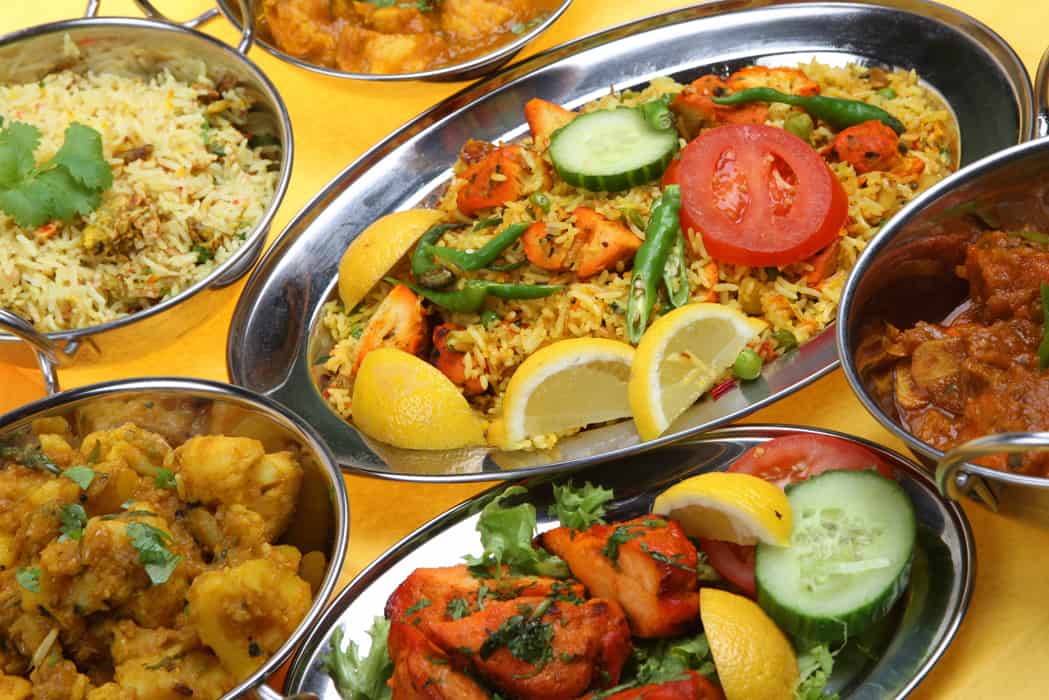 ShutterstockIndian food is indescribable. With no unified cuisine – just a vast array of regional specialties based on local climate and agriculture – the diversity of Indian food is what makes it so exciting.
ShutterstockIndian food is indescribable. With no unified cuisine – just a vast array of regional specialties based on local climate and agriculture – the diversity of Indian food is what makes it so exciting. Spices provide the link. No self respecting cook is ever without her/his blend of spices (masala) prepared to a personal formula. No dish is ever served without that pungent aroma which is derived from a judicious addition of spices. These spices – ginger, long pepper, black pepper, turmeric, cloves, nutmeg, mace, cinnamon, cardamom, coriander, cumin and chilli – are the foundation of Indian cooking. Their original use was as a preservative (in the tropics food decays rapidly), medicinal (the Ayurveda, the indigenous system of medicine, is littered with references to the curative properties of spices) and, of course, for flavouring.
The authentic cook painstakingly prepares powders and pastes for each dish. So no two dishes will ever taste alike as the proportions and combinations of the spice paste or powder vary. Spices change from region to region, and, from cook to cook – all part of the exquisite surprise and delight of Indian food.
An Elaborate Affair
Typically an Indian house features an open courtyard surrounded by corridors with pillars and large rooms with wooden doors. One of the rooms is the kitchen and the open corridor beside it is the dining area, so the food is served piping hot.
 Shutterstock
ShutterstockIndians maintain a high level of personal and household hygiene. The dining area is washed and cleaned elaborately. Diners are expected to bathe and change their clothes before dining on thin individual wooden blocks/pedestals/stools on the bare floor of the corridor. The food is served on a polished circular metal tray known as thali containing small bowls known as katoris. The rice or roti (leavened bread) is placed in the thali, while the vegetarian and non-vegetarian preparations are placed in the katoris. The thali with the katori is placed in front of the diner and it is refilled as required. Food is served directly from the cooking pots/utensils using ladles. Each prepared food is kept in separate vessels or utensils.
Indians eat with their hands or rather with their right hands. Usage of the left hand is frowned upon. There is a rigid etiquette involved eating with hands, it takes practice but once accomplished it becomes incredibly easy. Please note that beef is taboo to Hindus and pork is taboo to Muslims. Many Hindus and all the Jains are vegetarians.
Modern living has dramatically changed the lifestyle of Indians but cooking Indian cuisine has remained unchanged. It is said “food is a gift of the Gods.” In other words “to eat is a divine necessity”.
For a copy of our cuisine brochure please contact Indiatourism, Toronto at info@indiatrouismcanada.ca; it is available in both English and French.
So Many Flavours, So Little Time
 ShutterstockA great way to see something of the country and be sure you’re getting a taste of as many regional dishes as possible, I discovered, is to take a culinary tour.
ShutterstockA great way to see something of the country and be sure you’re getting a taste of as many regional dishes as possible, I discovered, is to take a culinary tour. I chose a 12-night tour visiting Southern India, and our guide offered fascinating insights on how history, religion, traditions, and climate have influenced the diet. Indian food (at least on my trip) is always prepared with fresh, local ingredients, so recipes are not exact – they vary according to local produce and preferences.
Mysore was our first major stop, famous for its silk, rosewood carvings, and its palace, modest compared with some other Indian national treasures, but nonetheless impressive. So was Ooty, or Uthagamandalam, home of the best-known hill station built by the British. These high peaks (the highest, Doddabetta, is 2,623 metres) host numerous tea plantations.
Dinner in Ooty featured dishes of the Nilgiris area (following a how-to demonstration), and I swear I can still taste the Nilgiri Chicken Korma. Its mild, sweet, flavour comes from coconut, mint, and coriander. Delicious.
Something I couldn’t get enough of was a sweet with the dubious name of barfi. It’s made from condensed milk (ubiquitous throughout India) cooked until solid. Too sweet for some on our tour, I unashamedly took their share. Ditto gulab jamun, another sweet made from fried milk balls (really) in a sweet syrup flavoured with cardamom and rosewater. And while we’re talking dessert, you’ll find rice puddings and bread puddings can actually taste exotic!
We talked food a lot, of course, and our tour included meeting people in the know from housewives to professional chefs. People like Nalini Verma, cooking instructor and author of four cookbooks. Her specialty is Kerala cuisine and one of the area’s best-known festive meals is the sadhya, a traditional vegetarian banquet eaten off banana leaves. Three or more rice courses form the base, with side dishes of vegetable and pulse stews. The flavours are piquant and delicious. And my sweet tooth was pleased with the Keralan dessert – payasam – wheat cooked in sweetened milk with spices, pistachios and raisins.
– Christine Potter


